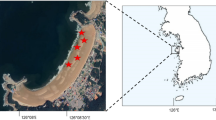Summary
Aspects of the demography of Monhystera disjuncta were investigated at different temperatures (in agnotobiotic cultures) and in different feeding conditions (monoxenic cultures with different bacterial strains, and different densities in the feeding suspension with one strain). Embryonic development time, minimum generation time, egg deposition rate and adult longevity depend on temperature, quality and quantity of food offered. Body mass at maturity is an allometric function of food density. It is shown that a previously inferred selectivity in food uptake is an artifact of culture conditions. pH buffering and addition of sterols permit culture of the species on a wide variety of bacterial strains. M. disjuncta is less well adapted to take advantage of high food density than are nematodes from polysaprobic environments. The animals channel surplus energy intake into a larger body mass, without being able to increase their rate of population growth accordingly.
Similar content being viewed by others
References
Abrams BI, Mitchell MJ (1980) Role of nematode-bacterial interactions in heterotropic systems with emphasis on sewage sludge decomposition. Oikos 35:404–410
Alongi DM (1985a) Microbes, meiofauna, and bacterial productivity on tubes constructed by the polychaete Capitella capitata. Mar Ecol 23:207–208
Alongi DM (1985b) Effect of physical disturbace on population dynamics and trophic interactions among microbes and meiofauna. J Mar Res 43:351–364
Andrassy I (1956) The determination of volume and weight of nematodes. Acta Zool Acad Sci Hung 2:1–15
Chitwood BG, Murphy DG (1964) Observations on two marine Monhysterids — their classification, cultivation and behaviour. Trans Am Microsc Soc 83:311–329
Deutsch A (1978) Gut ultrastructure and digestive physiology of two marine nematodes, Chromadorina germanica (Butschli 1874) and Diplolaimella sp. Biol Bull 155:317–335
Findlay SEG, Tenore KR (1982) Effect of a free-living marine nematode (Diplolaimalla chitwoodi) on detrital carbon mineralization. Mar Ecol 8:161–166
Gehan EA, Siddiqui MM (1973) Simple regression methods for survival time studies. J Am Stat Assoc 68:848–856
Gerlach SA, Schrage M (1971) Life cycles in marine meiobenthos. Experiments at various temperatures with Monhystera disjuncta and Theristus pertenuis (Nematoda). Mar Biol 9:274–280
Heip C, Vincx M, Vranken G (1985) The ecology of marine nematodes. Oceanogr Mar Biol 23:399–489
Herman PMJ, Vranken G, Heip C (1984) Problems in meiofauna energy flow studies. Hydrobiologia 118:21–28
Klekowski RZ, Schiemer F, Duncan A (1979) A bioenergetic study of a benthic nematode, Plectus palustris de Man 1880, throughout its life cycle. Oecologia (Berlin) 44:119–124
Pinder JEIII, Wiener JG, Smith MH (1978) The Weibull distribution: a new method of summarizing survivorship data. Ecology 59:175–179
Schiemer F (1982a) Food dependence and energetics of free-living nematodes. I. Respiration, growth and reproduction of Caenorhabdits briggsae at different levels of food supply. Oecologia (Berlin) 54:108–121
Schiemer F (1982b) Food dependence and energetics of free-living nematodes. II. Life history parameters of Caenorhabditis briggsae (Nematoda) at different levels of food supply. Oecologia (Berlin) 54:122–128
Schiemer F (1983) Food dependence and energetics of free-living nematodes. III. Comparative aspects with special consideration of two bacterivorous species Caenorhabditis briggsea and Plectus palustris. Oikos 41:32–43
Schiemer F, Duncan A, Klekowski RZ (1980) A bioenergetic study of a benthic nematode Pelodera palustris de Man, 1880, throughout its life cycle. Oecologia (Berlin) 44:205–212
Thun W von (1968) Autökologische Untersuchungen an freilebenden Nematoden des Brackwassers. Diss. Kiel, p 72
Tietjen JH (1980) Microbiol-meiofaunal interrelationship: a review. In: Microbiology 1980. VIII. Conf. Amer. Soc. Microbiol on Ecology, Feb. 7–10, 1979, Clearwater Beach, Florida. Amer Soc Microbiol, Washington, DC, USA, pp. 335–338
Trotter D, Webster JM (1984) Feeding preferences and seasonality of free-living marine nematodes inhabiting the kelp Macrocystis integrifolia. Mar Ecol 14:151–157
Vanfleteren JR (1980) Nematodes as nutritional models. In: Zuckerman BM (ed) Nematodes as biological models, vol 2. Academic Press, New York, pp 47–79
Vlasblom AG (1963) Het schelpdierlarvenonderzoek in het laboratorium te Wemeldinge van 11 juli 1955–31 juli 1963. Internal report, 218 pp
Vranken G, Heip C (1983) Calculation of the intrinsic rate of natural increase, r m with Rhabditis marina Bastian 1963 (Nematoda)with Rhabditis marina Bastian 1963 (Nematoda). Nematologia 29:468–477
Vranken G, Heip C (1986) The productivity of marine nematodes. Ophelia 26:429–442
Vranken G, Thielemans L, Heip C, Vandycke M (1981) Aspects of the life-cycle of Monhystera parelegantula (Nematoda, Monhysteridae). Mar Ecol 6:67–72
Vranken G, Van Brussel D, Vanderhaeghen R, Heip C (1984) Research on the development of a standardized ecotoxicological test on marine nematodes. I. Culturing conditions and criteria for two Monhysterids, Monhystera disjuncta and Monhystera microphthalma. In: Persoone G, Jaspers E, Claus (eds) Ecotoxicological testing for the marine environment, vol 2. State University of Ghent and Inst. Mar. Scient. Res., Bredene, Belgium, pp. 159–184
Vranken G, Vanderhaeghen R, Heip C (1985) Toxicity of cadmium to free-living marine and brackish-water nematodes (Monhystera microphthalma, Monhystera disjuncta, Pellioditis marina). Dis aquat org 1:49–58
Vranken G, Herman PMJ, Vincx M, Heip C (1986) A reevaluation of marine nematode productivity. Hydrobiologia 135:193–196
Author information
Authors and Affiliations
Rights and permissions
About this article
Cite this article
Vranken, G., Herman, P.M.J. & Heip, C. Studies of the life-history and energetics of marine and brackish-water nematodes. Oecologia 77, 296–301 (1988). https://doi.org/10.1007/BF00378033
Received:
Issue Date:
DOI: https://doi.org/10.1007/BF00378033




